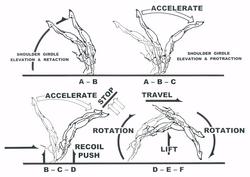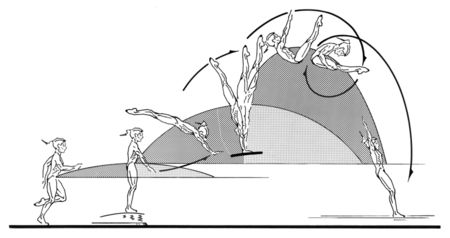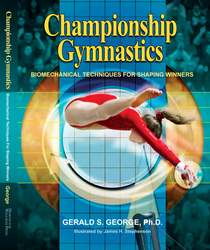|
|
Not until mastery of the basic skills has been fully ingrained and demonstrated over an extended period should the performer proceed to the next level. At first blush, this approach may appear inefficient and cumbersome, lacking in any real productivity. One might ask, "Why spend seemingly inordinate amounts of time practicing what I can already do reasonably well?" The truth is that advanced skills are really nothing more than a properly integrated series of basic movements. Although it may appear initially that the race is being lost:
Never forget the story of the tortoise and the hare!
|
|
Persistent Use of Repetitions
|
The only realistic way to achieve task mastery of any gymnastics skill or element is through the persistent use of repetitions. This does not simply imply repetition is necessary to the learning of skills. More importantly, it points to the relentless use of repetitions applied to skills that have already been learned. The basic idea here is to ensure that a vast majority of the daily workout session deals with successful executions, rather than some haphazard trial-and-error scenario wherein the performer's experiences are mostly centered in confusion, frustration, and failure.
Train smart, train hard, train forever,
that the seasons of victory are yours and not your inheritors'.
|
"Championship Gymnastics" -- Featuring 140 Gymnastic Illustrations
Called "A True Masterpiece" by International Gymnast Magazine
Currently Used In 38 Countries Worldwide! |
  140 Illustrations Show You the Exact Positions and Movements for Achieving Success and Shaping Championship Winners. 140 Illustrations Show You the Exact Positions and Movements for Achieving Success and Shaping Championship Winners.
Rather than laboring on complex physics formulas, fundamental principles of biomechanics are clearly explained and presented in layman's terms.
Easy to read and expertly illustrated, readers are guided effortlessly through a "conceptualization process" for developing ideal movement patterns. The book includes 140 technical illustrations by noted artist and gymnastics coach Jim Stephenson.
|
Get the Tools and Learn the Techniques You Need
to Become a Championship Winner!
- Learn Time-Tested Principles for Shaping Winners
- 140 Illustrations Show You the Exact Positions and Movements for Achieving Success and Shaping Championship Winners
- Understand the Biomechanical Principles Underlying All Gymnastics Skills
- Learn the Fundamental Concepts of Proper Training for Power and Flexibility
- Apply an Easy-to-Follow System for the Fundamental Patterns of Gymnastics Movement
- Discover Ten Key Teaching Concepts for Success in Each of the Four Olympic Gymnastics Events for Women
Take this opportunity to be among the first to receive the valuable information contained in this book, and start or continue your journey to achieve success in winning gymnastics championships!
|